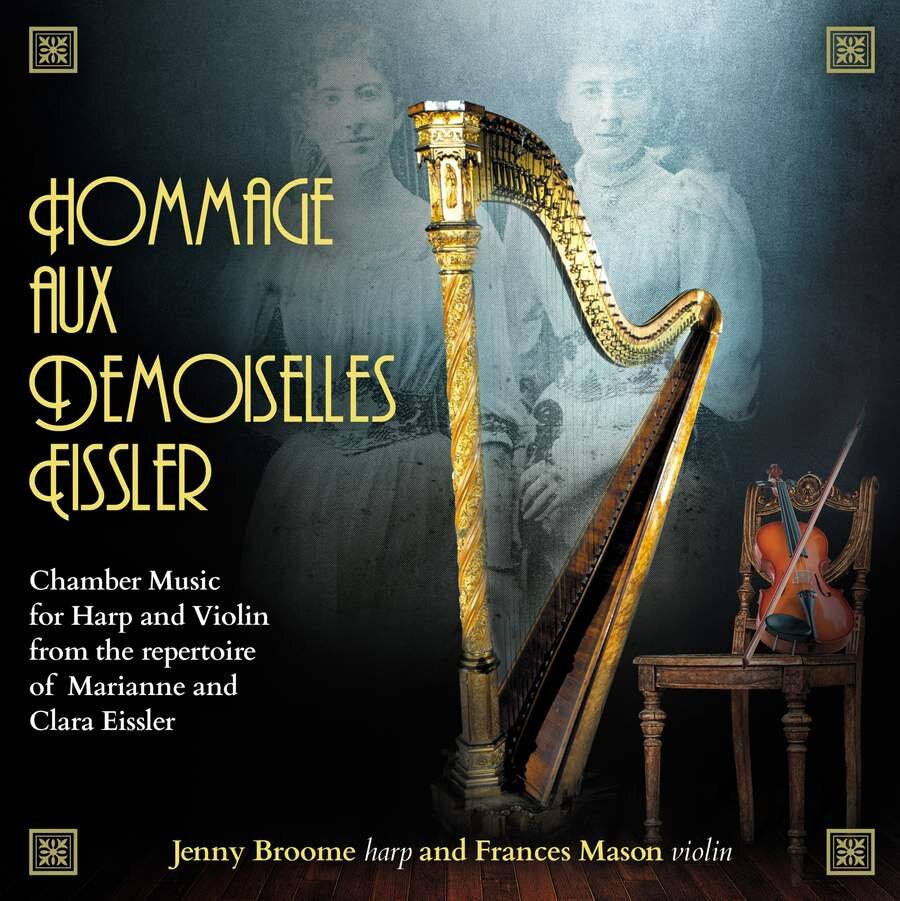Hommage aux Demoiselles Eissler
Chamber music for Harp & Violin from the repertoire of Marianne & Clara Eissler
Artist: Jenny Broome (harp) and Frances Mason (violin)
Listen Here…
Release Date: 1st June 2018
Format: Single CD/Standard Jewel Case
Tracklisting
Carl Oberthür: Berceuse Op 299; Louis Spohr: Sonate in C minor; Alphonse Hasselmans: Valse de Concert Op 4; Francis Thomé: Andante Religioso Op 70; Camille Saint-Saëns: Fantaisie Op 124; Charles Villiers Stanford: Caoine Op 54 No.1; Gabriel Pierné: Sérénade Op 7; Wagner/August Wilhelmj: Preislied; Richard Pohl: Wiegenlied; John Thomas: Larghetto
Project Information
Saint-Saëns Fantaisie Op 124 for violin and harp stands alone in the repertoire. In planning recital programmes it is good to be able to include music from a range of styles, so Marianne and Clara Eissler, the dedicatees of the Fantaisie, offered the possibility of finding a repertoire from an earlier age. Musical historians tell us very little about them, but in their day, they were celebrated performers, known and loved by people all over Europe. Uncovering their lives and the music they played has been largely a matter of searching newspaper reports. They lived at a time of great wealth and great houses, of railway travel, of life lived in public, of news widely disseminated and repeated. The music they played is essentially Victorian, but the titles and associations hide music that has its own charm. This was an age when a large and diverse audience listened to and enjoyed classical music, and when the aristocratic element of that audience was well educated in music and supported and enabled its performance. The story of the Eisslers is also a story of women fighting to build careers as independent women at a time when most careers were cut short by marriage.
In addition to the Saint-Saëns “Fantaisie”, this recording features pieces by Carl Oberthür, Louis Spohr, Alphonse Hasselmans, Francis Thomé, Charles Villiers Stanford, Gabriel Pierné, August Wilhelmj (after Wagner), Richard Pohl and lastly John Thomas (harpist to Queen Victoria).
The CD booklet contains highly informative notes by Jenny Broome.
Artist Information
Frances Mason almost started to play the violin by default. Her brother, five years older, was given the opportunity to learn with a visiting teacher who owned a special quarter size violin. “Isn’t there anyone who could use this?” she asked, and thankfully that is how Frances got started.
In her formative years, Frances had a succession of respected teachers in Elizabeth Hunt, Albert Sammons and Alan Loveday. At the RCM that she came across chamber music for the first time, because as a scholar she was put into a string quartet on arrival, under the tutorage of cellist Harvey Phillips. She was approached by Roderick Biss, a New Zealand composer, to play his sonata, and met his compatriot Ashley Lawrence, with whom she played for many years in international competitions and broadcasts, until he became a full-time conductor. Her reputation as an outstanding violinist led to solo work including the Proms. It was a wonderful time for young chamber musicians, with much broadcasting as well as concerts. In addition, she earned a professorship at the RCM.
Frances joined The Music Group of London as second violin to Hugh Bean, also a Sammons pupil, so chamber music with piano and wind continued. Later, the cellist Joy Hall, whom she had met in the Julian Bream Ensemble, invited Frances to join the Rasumovsky String Quartet. The second violin was Gregory Warren-Wilson, an ex-pupil of hers at the College and now a successful poet. Later the viola-player, Christopher Wellington, joined the quartet. Her Tagore Piano Trio, started at the RCM, became The Tagore String Trio, and so that wonderful repertoire became familiar, with performances and recordings.
Although Frances already had a rich career of music making with the violin, the area she really wished to explore were the duos which Spohr had written for himself and his harpist wife, and so when she met Jenny Broome her chance came, and with it a new friendship and new repertoire.
Jenny Broome started piano lessons aged five or six, and very soon her mother encouraged her to
play piano duets, but as many children do, she wearied of the piano, so her mother insisted that she take up another instrument. Jenny was attracted to the harp with its complexity and beautiful shape and sound and was very lucky to be accepted as a total beginner at the Junior Royal College of Music. Under her tutor, Daphne Boden, she acquired a solid technique, covering a lot of repertoire, and so her love of the harp was born!
Nevertheless, music didn’t seem an appropriate career, and instead she won a place at Cambridge to study architecture, but couldn’t quite abandon music, and spent her gap year studying with Renata
Scheffel-Stein. At Cambridge she had some wonderful musical experiences, between project reviews, dissertations and a lot of late-night drawing, including performing the War Requiem in King’s College Chapel as part of the chamber orchestra conducted by David Hill, appearing at the Aldeburgh Festival in a chamber opera by Matthew Best, and at the Edinburgh Fringe in Britten’s Rape of Lucretia.
After a few years working in architecture, a big recession in the construction industry shifted the balance back towards music, which had always been there, pulling. Alongside teaching the orchestral playing gradually increased, and there were opportunities for concerto playing and some of the big harp showpieces. Highlights have come from surprising directions: working for the Royal Shakespeare Company for Richard Jones’s production of A Midsummer Night’s Dream with music by Jonathan Dove, and much later giving the first public performance at very short notice of Dove’s opera Seven Angels for two voices and harp; working with Andrew Parrott to record Berlioz’s trio from the Childhood of Christ; being part of the team for Stowe Opera’s magical production of Rusalka; emotional performances of Peter Grimes with Richard Hickox at the Endellion Festival.
Those early piano duets led to a love of chamber music, and she explored the now quite extensive repertoire for flute, viola and harp, with Trio Sospiroso, as well as a wide range of chamber music for a variety of line-ups. Jenny also formed the harp duo, Arcangeli, with Helena de Rijke.
In 2007 she was invited to play in a charity concert and was delighted when Frances Mason approached her to collaborate in a performance of Spohr’s music for violin and harp. These are demanding and virtuosic works which they have explored together, tracking down a wide repertoire to build programmes around them, and commissioning Speed Matters from Edward Lambert, who has also written two other works for her – Concerto Cubico, for trombone, marimba and harp, and Short Story, for flute viola and harp.

